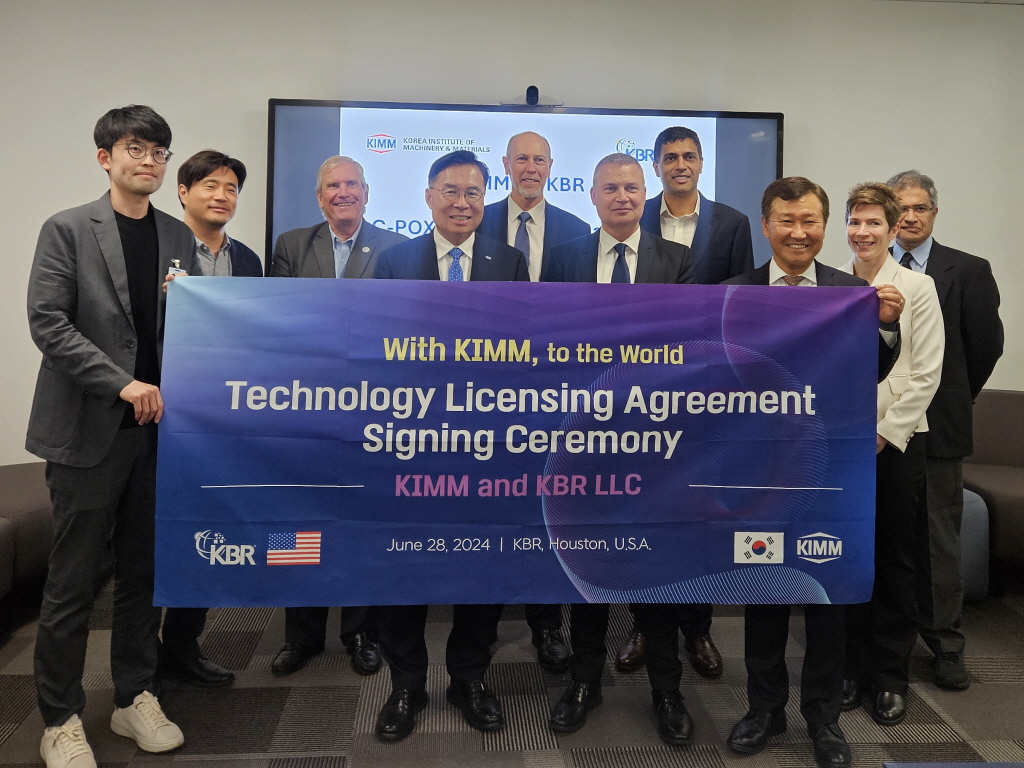과학기술정보통신부 산하 한국기계연구원(원장 류석현)이 출연연 간 융합연구를 통해 창출한 고유의 탄소 저감 기술을 북미 최대 글로벌 엔지니어링 회사인 KBR(Kellogg Brown & Root)에 기술이전하는 쾌거를 거뒀다. 이번 기술이전 성과로 우리나라 화학 공정 기술의 우수성이 세계적으로 입증됐으며, 향후 글로벌 산업계로의 ‘K-Machine’ 도약에 주춧돌이 될 것으로 보인다.

▲(왼쪽 4번째)기계연 류석현 원장 등 기계연, KBR 임직원들이 계약 체결 후 기념촬영을 하고 있다.
美 KBR 기술이전, 촉매방식 NCC 공정 적용
과학기술정보통신부 산하 한국기계연구원(원장 류석현)이 출연연 간 융합연구를 통해 창출한 고유의 탄소 저감 기술을 북미 최대 글로벌 엔지니어링 회사에 기술이전하는 쾌거를 거뒀다. 이번 기술이전 성과로 우리나라 화학 공정 기술의 우수성이 세계적으로 입증됐으며, 향후 글로벌 산업계로의 ‘K-Machine’ 도약에 주춧돌이 될 것으로 보인다.
기계연은 현지시각으로 6월28일에 글로벌 엔지니어링 회사 KBR(Kellogg Brown & Root)과 CPOx®기술 이전 계약을 체결했다고 1일 밝혔다.
KBR(Kellogg Brown & Root)은 1998년 MW Kellogg가 Halliburton의 건설 자회사인 Brown & Root와 합병해 설립한 화학/에너지 산업 등의 엔지니어링, 조달, 건설(EPC) 및 서비스 분야의 글로벌 기업이다.
CPOx(Catalytic Partial Oxidation)® 기술은 촉매 부분 산화 기술로서, 촉매방식 NCC공정의 촉매재생기 연료 다변화를 통한 CO2 저감 기술이다.
기계연 자율제조연구소 반도체장비연구센터 이대훈 책임연구원, 조성권 책임연구원 연구팀이 처음으로 고안한 CPOx® 기술은 촉매방식 NCC 공정의 촉매 재생기에 연료유(Fuel Oil) 대신 공정 과정에서 발생하는 메탄을 열원으로 공급해 CO2 배출을 줄이는 기술이다.
CO2 감축과 경제성 확보를 위해 촉매방식 NCC 공정에서 촉매 재생기에 필요한 열원을 연료유(Fuel Oil)에서 메탄으로 대체해야 하는 필요성이 대두되었지만, KBR의 촉매방식 NCC 공정인 ‘K-COT 공정’은 공정 부생가스인 메탄을 열원으로 공급할 때 고질적인 이상연소(After-burn) 문제가 발생하여 메탄 사용이 불가능했다.
기계연이 개발한 CPOx® 기술은 ‘K-COT 공정’에서 메탄을 촉매에 반응시켜 일산화탄소(CO)와 수소(H2)로 분해하고 촉매 재생기로 공급하는 기술이다. 이 기술을 통해 이상연소 문제를 해결할 수 있고, 이에 따라 탄소배출권을 확보해 올레핀(Olefin) 생산 단가를 절감할 수 있다.
기계연 이대훈 책임연구원은 “연구의 시작 단계부터 현장의 수요에 기반한 목표 설정을 통해 문제 발굴, 솔루션 개발, 공정 적용성 확보를 추진하여 이룬 성과”라며 “CPOx® 공정 기술을 시작으로 다양한 세계 최고의 공정 기술을 개발해 국가 기술 경쟁력 향상에 기여하겠다”고 말했다.
기계연 류석현 원장은 “탄소국경세 등 탄소 배출이 기업 경쟁력을 위협하는 가운데 KBR과 같은 세계적인 기업에 우리 연구원의 독자적인 기술로 탄소 배출 저감 관련 기술이전 성과를 이뤘다는 데 매우 의미가 크다”며 “앞으로도 기계연의 미래를 선도하는 우수한 기술들이 글로벌 산업 시장에서 가시적인 성과를 낼 수 있도록 실질적인 국제협력 네트워크를 확대하겠다”고 밝혔다.
기술이전 계약을 체결한 CPOx® 기술 연구는 과학기술정보통신부 국가과학기술연구회 ‘에너지 및 화학 원료 확보를 위한 대형 융합 플랜트 기술(주관: 한국화학연구원, 미래선도형 융합연구단, 박용기 단장)’ 과제 지원을 받아 수행됐다.
한편 기계연은 기관 고유의 글로벌 협력 프로그램인 ‘With KIMM, to the World’를 운용하고 있다. 기계연 류석현 원장과 연구진은 KBR사 기술이전 체결식에 앞서 지난 6월24일부터 26일까지 미국 보스턴 하버드의대와 매사추세츠 종합병원(MGH), 매사추세츠 공대(MIT), 미국 메릴랜드 국립표준기술연구소(NIST) 등을 방문했다.
연구진은 △현장형 면역진단 △차세대 고해상도 Micro-LED 디스플레이 △양자 기술 표준화 및 나노 분야 등에서 산업통상자원부 글로벌산업기술협력센터 (GITCC) 및 산업기술국제협력지원단(NCC) 사업 등을 통한 긴밀한 국제공동 연구 협력 방안에 대해 협의했다. 이어 6월27일에는 산업통상자원부와 한국산업기술진흥원이 주최·주관한 ‘제3회 한-미 첨단산업기술협력포럼’에 참석해 MIT 등과 공동 포럼을 개최한 바 있다.
